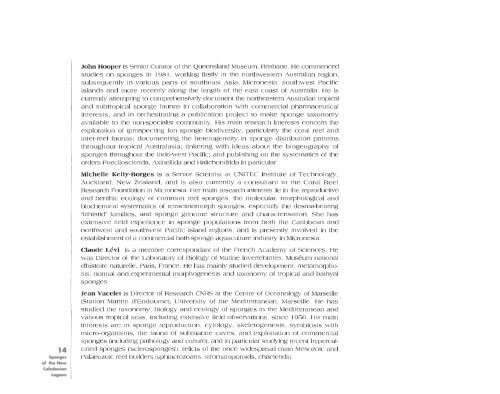Sponges of the New Caledonian lagoon - IRD
Sponges of the New Caledonian lagoon - IRD
Sponges of the New Caledonian lagoon - IRD
You also want an ePaper? Increase the reach of your titles
YUMPU automatically turns print PDFs into web optimized ePapers that Google loves.
14<br />
<strong>Sponges</strong><br />
<strong>of</strong> <strong>the</strong> <strong>New</strong><br />
<strong>Caledonian</strong><br />
Lagoon<br />
John Hooper is Senior Curator <strong>of</strong> <strong>the</strong> Queensland Museum, Brisbane. He commenced<br />
studies on sponges in 1981, working firstly in <strong>the</strong> northwestern Australian region,<br />
subsequently in various parts <strong>of</strong> sou<strong>the</strong>ast Asia, Micronesia, southwest Pacific<br />
islands and more recently along <strong>the</strong> length <strong>of</strong> <strong>the</strong> east coast <strong>of</strong> Australia. He is<br />
currently attempting to comprehensively document <strong>the</strong> nor<strong>the</strong>astern Australian tropical<br />
and subtropical sponge faunas in collaboration with commercial pharmaceutical<br />
interests, and in orchestrating a publication project to make sponge taxonomy<br />
available to <strong>the</strong> non-specialist community. His main research interests concern <strong>the</strong><br />
exploration <strong>of</strong> (prospecting fOr) sponge biodiversity, particularly <strong>the</strong> coral reef and<br />
inter-reef faunas; documenting <strong>the</strong> heterogeneity in sponge distribution patterns<br />
throughout tropical Australasia; tinkering with ideas about <strong>the</strong> biogeography <strong>of</strong><br />
sponges throughout <strong>the</strong> Indo-west Pacific; and publishing on <strong>the</strong> systematics <strong>of</strong> <strong>the</strong><br />
orders Poecilosclerida, Axinellida and Halichondrida in particular.<br />
Michelle Kelly-Borges is a Senior Scientist at UNITEC Institute <strong>of</strong> Technology,<br />
Auckland, <strong>New</strong> Zealand, and is also currently a consultant to <strong>the</strong> Coral Reef<br />
Research Foundation in Micronesia. Her main research interests lie in <strong>the</strong> reproductive<br />
and benthic ecology <strong>of</strong> common reef sponges, <strong>the</strong> molecular, morphological and<br />
biochemical systematics <strong>of</strong> tetractinomorph sponges, especially <strong>the</strong> desma-bearing<br />
"lithistid" families, and sponge genome structure and characterisation. She has<br />
extensive field experience in sponge populations from both <strong>the</strong> Caribbean and<br />
northwest and southwest Pacific island regions, and is presently involved in <strong>the</strong><br />
establishment <strong>of</strong> a commercial bath-sponge aquaculture industry in Micronesia.<br />
Claude Levi is a membre correspondant <strong>of</strong> <strong>the</strong> French Academy <strong>of</strong> Sciences. He<br />
was Director <strong>of</strong> <strong>the</strong> Laboratory <strong>of</strong> Biology <strong>of</strong> Marine Invertebrates, Museum national<br />
d'histoire naturelle, paris, France. He has mainly studied development, metamorphosis,<br />
normal and experimental morphogenesis and taxonomy <strong>of</strong> tropical and bathyal<br />
sponges.<br />
Jean Vacelet is Director <strong>of</strong> Research CNRS at <strong>the</strong> Centre <strong>of</strong> Oceanology <strong>of</strong> Marseille<br />
(Station Marine d'Endoume), University <strong>of</strong> <strong>the</strong> Mediterranean, Marseille. He has<br />
studied <strong>the</strong> taxonomy, biology and ecology <strong>of</strong> sponges in <strong>the</strong> Mediterranean and<br />
various tropical seas, including extensive field observations, since 1956. His main<br />
interests are in sponge reproduction, cytology, skeletogenesis, symbiosis with<br />
micro-organisms, <strong>the</strong> fauna <strong>of</strong> submarine caves, and exploitation <strong>of</strong> commercial<br />
sponges (including pathology and culture), and in particular studying recent hypercalcified<br />
sponges ('sclerosponges'), relicts <strong>of</strong> <strong>the</strong> once Widespread main Mesozoic and<br />
palaeozoic reef builders (sphinctozoans, stromatoporoids, chaetetids).

















